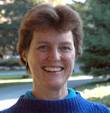

Wednesday - March 25, 2009
SLAC Today is
available online at:
http://today.slac.stanford.edu
In this issue:
People: SSRL's New CAMS Group Has Great Chemistry
Activity and Training Authorization to Replace the JHAM
WIS Seminar Today: Effects of Gendered Language in Environmental Policy
 |
 |
|
Wednesday - March 25, 2009 |
People: SSRL's New CAMS Group Has Great ChemistryThe staff scientists of the SSRL Chemical and Materials Science and User Support Group.
Back, left to right: Rob Moore, Uwe Bergmann, Dennis Nordlund, John Pople. Front
row: Hendrik Ohldag, Hirohito Ogasawara, Joy Hayter, Donghui Lu.
(Not pictured: Stefan Mannsfeld, Apurva Mehta and Michael Toney. (Photo by Lauren Schenkman. Click for larger image.)
The Stanford Synchrotron Radiation Lightsource at SLAC is an invaluable resource for researchers studying everything from the ebola virus to carbon nanotubes. Scientists from all over the world compete to bring their research here, and the SSRL's bright X-rays aren't the only reason. "The people at SSRL really make it stand out from other facilities," said Pierre Kennepohl, a University of British Columbia chemist studying sulfur oxidation at Beamline 4-3. That may be because SSRL's staff scientists have an unusual amount of independence; they spend only half their time helping users launch and maintain experiments in the beamlines. The other half is dedicated to pursuing their own research topics, which vary as widely as the specialties of the visiting users. "The biggest thing is that they understand not just what you're trying to do, but why you're trying to do it," Kennepohl said. "It really does make a difference when you're working with people who do their own research." Read more... Activity and Training Authorization to Replace the JHAMAs part of ongoing improvements to SLAC work planning and control processes, an Activity and Training Authorization will be required for many SLAC staff starting July 1, 2009. The new ATA form identifies the activities that a worker is qualified, authorized and released to perform in their resident work area. It replaces the Routine Job Hazard Analysis & Mitigation, or JHAM, which will no longer be used. Supervisors will be expected to review ATAs with his or her employees, on an individual or group basis, to discuss the work expected of them and clarify expectations. During the upcoming performance review cycle, supervisors are expected to create an ATA for those employees requiring one. The ATA lists type of work, hazards, controls, training and qualifications, affirming the individual is aware of hazards associated with his or her day-to-day work and is competent to perform the assigned work. The ATA also establishes boundary conditions so that workers are clear on what they may and may not do. An ATA is not required for employees who perform work categorized as green or office-type work. Green work includes those activities that require neither a permit or plan to control the hazards, nor Environment, Safety and Health training. For work outside your resident work area, a Job Safety Analysis or Standard Operating Procedure will document and authorize the work. A JSA includes job steps, hazards and controls needed to perform the work safely. A JSA may be subsequently converted into an SOP if the work activity is expected to be repeated with some regularity. The SOP then may be used to authorize work. For more information about the ATA and related work planning and control documents, see Work Planning & Control Forms and Refereneces, including the ATA FAQ, on the Work Planning and Control Web site. WIS Seminar Today: Effects of Gendered Language in Environmental Policy
Marianne Neuwirth.
Today from noon to 1:00 p.m. in Panofsky Auditorium, the Women's Interchange at SLAC presents Stanford lecturer Marianne Neuwirth, speaking about "The Gendering of Nature and its Effects on Environmental Organizations' Practices." How might gendered language such as "mother nature" or the masculine notion of self-reliance in the context of "wilderness" affect policy decisions regarding the natural world? What limits might these constructions impose on envisioning comprehensive solutions to environmental challenges? In this talk, Neuwirth will focus on the pivotal role that language and socialization play in defining our ideas about the natural world, and our subsequent decisions in relation to it. Neuwirth's PhD is in communication. She developed expertise in the areas of environmental communication and conflict resolution, both from a feminist perspective. She is currently a lecturer in the Center for Teaching and Learning at Stanford. |
Events (see all | submit)
Access (see all)
Announcements
|
|
| | ||
|
|
||
 <%
Response.AddHeader "Last-modified", getArticleDate()
'Response.AddHeader "Last-modified","Mon, 01 Sep 1997 01:03:33 GMT"
'Monday, December 06, 2010
%>
<%
Response.AddHeader "Last-modified", getArticleDate()
'Response.AddHeader "Last-modified","Mon, 01 Sep 1997 01:03:33 GMT"
'Monday, December 06, 2010
%>View online at http://today.slac.stanford.edu/. |
||